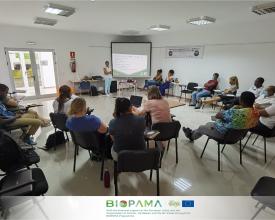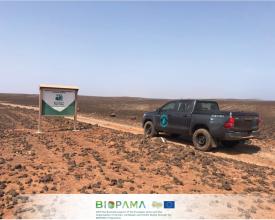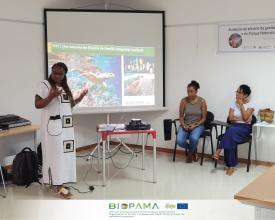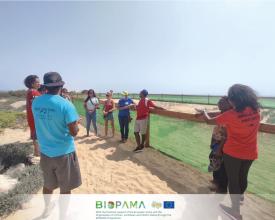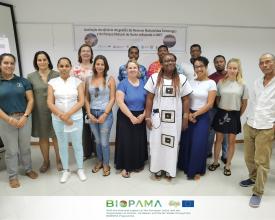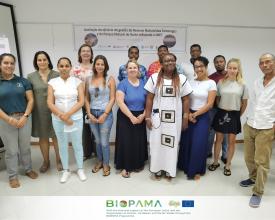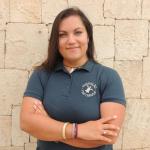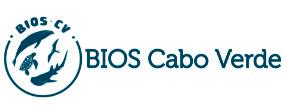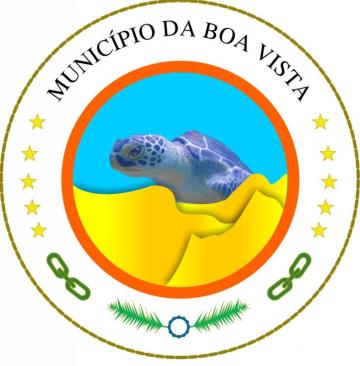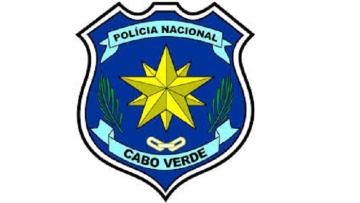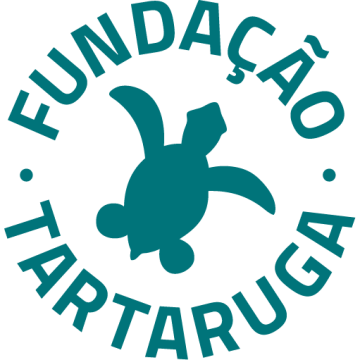
Utilisation de l'EIPMF pour identifier les priorités de gestion dans deux zones protégées à Boa Vista, Cabo Verde
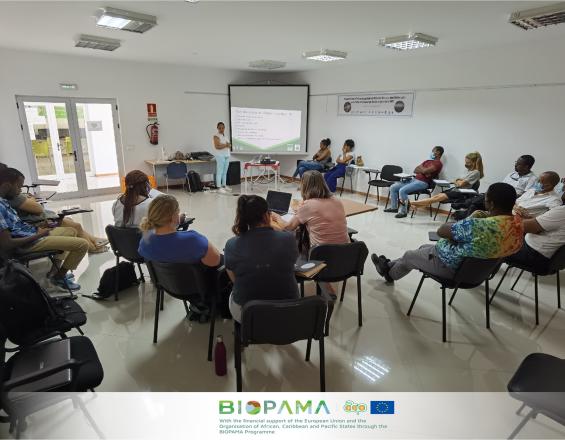
Le Cap-Vert est un archipel (4 030 km²) situé dans l'océan Atlantique à 570 km à l'ouest de l'Afrique. Il est reconnu comme un point chaud de la biodiversité marine et a établi 47 zones protégées, dont la majorité a été désignée en 2003. Le processus d'évaluation de la gestion de la Reserva Natural das Tartarugas (RNT) et du Parque Natural do Norte (PNN), situés sur l'île de Boa Vista, à l'aide de l'outil de gestion intégrée de l'efficacité (IMET) en octobre 2021 a permis aux principales parties prenantes de mieux comprendre les défis de la gestion. Cela a incité tout le monde à poser des questions et à élargir les connaissances disponibles pour toutes les parties prenantes concernant les forces et les faiblesses des deux aires protégées. Nous avons pu identifier les domaines prioritaires en tant que groupe et pour chaque partie prenante. Nous avons constaté que les aires protégées manquaient de ressources financières et humaines, ainsi que de données sur la biodiversité et le suivi du changement climatique. La Fundação Tartaruga a initié cette formation en partenariat avec le ministère de l'environnement local (MAA-BV) et elle a été financée par BIOPAMA.
Contexte
Défis à relever
Le Cabo Verde a officiellement établi 47 zones protégées (ZP). Toutefois, le pays ne dispose pas de données facilement accessibles sur ses zones protégées. Seules 7 d'entre elles sont enregistrées dans la base de données mondiale des zones protégées. Il y a également un manque d'informations sur le climat, l'habitat, les espèces, la biodiversité et les écorégions, ou une classification erronée.
Dans les deux sites, les principales menaces sont centrées sur les conflits entre l'homme et la faune, y compris le braconnage et la dégradation de l'habitat, la pollution marine et les activités touristiques non réglementées. Le plan de gestion et le plan d'action pour les aires protégées de Boa Vista ne sont pas alignés et ne sont pas spécifiques au site, ce qui signifie qu'une grande partie des objectifs de gestion ne sont pas applicables à ces aires protégées.
Emplacement
Traiter
Résumé du processus
Tous les éléments sont nécessaires pour rendre ce processus efficace. Il était essentiel d'identifier les bonnes parties prenantes, mais il est clair que tout le monde devait être formé à l'EIPMF, pour s'engager pleinement dans le processus et comprendre les résultats de l'évaluation. L'élément de base n° 3 - l'identification des sources de données - est essentiel car l'un des principaux défis de ces deux parcs est le manque d'informations de base. Cependant, ces informations de base ne sont pas disponibles sans les parties prenantes (#1) et sans la formation sur la manière d'identifier les données (#2). L'interprétation des résultats (#4) nous permet de diffuser les informations recueillies au cours de l'évaluation et de jeter les bases d'une action future.
Blocs de construction
1 Engager les principales parties prenantes
L'évaluation IMET est un processus participatif. Par conséquent, lors de la préparation de l'atelier avec le ministère local de l'environnement, nous avons essayé d'identifier les parties prenantes représentatives de toutes les parties intéressées au sein des aires protégées. Les parties prenantes suivantes ont participé à l'atelier : Fundação Tartaruga (FT), Ministère de l'Agriculture et de l'Environnement de Boa Vista (MAA-BV), BIOS CV, Cabo Verde Natura 2000, Turtle Foundation (TF), Câmara Municipal Boa Vista (CMBV), Society of Tourism Development in Boa Vista and Maio (STDIBVM), Varandinha Association, Port Maritime Institute (IMP), Police Nationale y compris la Police Maritime.En outre, le directeur national de l'environnement, l'association des opérateurs touristiques, les inspecteurs des pêches et d'autres dirigeants communautaires ont été invités mais n'ont pas assisté à la réunion. Ils ont été informés qu'il s'agissait d'un processus participatif qui permettrait aux voix et aux opinions de chacun d'être entendues et enregistrées dans l'évaluation. Le vote de chaque représentant a été pris en compte de la même manière et il s'agissait donc d'un processus très inclusif.
Facteurs favorables
La participation et la contribution de toutes les personnes impliquées ont été fantastiques. Les membres ont pu voir clairement l'idée derrière l'outil et à la fin de l'atelier, les résultats étaient très clairs et représentatifs des défis auxquels toutes les parties prenantes sont confrontées lorsqu'elles interagissent avec les aires protégées.
Tout le monde a été invité à participer aux sessions en ligne pour comprendre le processus et l'idée de l'évaluation, ce qui a rendu les sessions en face à face plus efficaces.
La communication entre les parties prenantes (lusophones) et le formateur (anglophone) était très importante.
Leçon apprise
Inclusivité ! Afin de rendre le processus accessible à toutes les parties intéressées, deux traducteurs étaient présents lors de l'atelier et ont traduit toute la correspondance, les rapports et les présentations en portugais et en anglais. Cela a permis aux habitants de tous les horizons de partager leurs idées et leurs opinions sur la gestion de leurs parcs locaux et d'exprimer ce qu'ils pensent qu'il faudrait faire.
Les relations entre les ONG de l'île ont toujours été mauvaises, mais ce processus a permis aux représentants des ONG de s'unir pour présenter des arguments sur ce qui, selon eux, devrait être une priorité dans la gestion des aires protégées en termes d'espèces et d'habitats et de l'écosystème dans son ensemble.
Il n'y a pas une seule bonne réponse. La compréhension du compromis est également essentielle dans la mesure où tout le monde ne peut pas obtenir exactement ce qu'il veut. Les parties prenantes ayant des besoins, des désirs ou des demandes divergents ont eu l'occasion de présenter leur point de vue et les raisons qui le motivent. Les parties prenantes situées sur le spectre des opinions divergentes ont dû décider de la position qu'elles allaient soutenir.
2 Formation et accompagnement
En préparation de l'évaluation, tous les participants ont été invités et ont pris part à deux réunions en ligne avec Bertille Mayen, une experte en IMET (également appelée coach IMET), qui a expliqué à tous ce qu'est l'IMET et ce que le projet espérait réaliser. Au cours de ces réunions en ligne, elle a demandé à ce que toute la documentation relative aux aires protégées soit mise à sa disposition et à celle des autres participants avant l'atelier.
Au total, 18 personnes ont participé à l'atelier de formation IMET. Il s'agissait d'organisations très diverses et de personnes venant d'horizons variés et ayant des intérêts différents.
Tous les participants ont téléchargé le logiciel IMET et l'ont utilisé à titre expérimental pour se familiariser avec le programme avant l'atelier en personne. Bertille a offert des conseils supplémentaires et des réunions en ligne à tous ceux qui rencontraient des difficultés techniques. Les participants comprenaient des scientifiques locaux, des membres du conseil municipal, la police locale, un étudiant en master, des membres d'ONG locales et internationales, le gestionnaire de l'aire protégée, un membre de la communauté, un technicien en développement touristique et deux traducteurs.
Facteurs favorables
Tous les participants ont eu l'occasion d'acquérir de nouvelles compétences et de nouvelles connaissances.
Il a permis aux membres de la communauté d'exprimer leurs craintes et leurs espoirs dans un environnement sûr et contrôlé et leur a donné l'occasion d'apporter des solutions.
Un échange de connaissances et une meilleure compréhension des problèmes et de la manière de les résoudre.
La création d'un canal de communication entre les membres de la communauté locale et le directeur de l'environnement de la capitale.
Leçon apprise
- L'importance de partager les informations et les données et de les rendre accessibles à toutes les parties intéressées.
- Il est essentiel de permettre aux opinions et visions divergentes d'être entendues et de les utiliser pour créer des idées de changement.
- Tous les participants ont pu apprendre que chaque partie prenante avait quelque chose de précieux à apporter au processus.
3 Identifier les sources de données
Pendant les formations en ligne et en personne, un disque dur Google a été créé où les participants pouvaient télécharger diverses lois, politiques et documents pour faciliter le processus. Cela a rendu tout accessible à tout le monde et a permis à toutes les parties prenantes d'apprendre autant ou aussi peu qu'elles le souhaitaient. Bertille a montré à chacun où trouver les plans de gestion et les règlements des zones protégées. La responsabilité de trouver des données spécifiques à présenter au groupe a été divisée et attribuée à chaque participant.
Facteurs favorables
- Tous les participants ont appris à trouver des informations, notamment sur les lois et les objectifs et sur leur origine. Par exemple, les objectifs d'Aichi.
- Tous les participants ont partagé leurs connaissances les uns avec les autres, ce qui a constitué un énorme exercice de renforcement des capacités.
Leçon apprise
- Alors qu'au départ nous pensions que certaines données n'existaient pas, nous avons pu, au cours du processus et en rassemblant des individus, combler une grande partie des lacunes en matière de connaissances.
- Tous les participants seraient en mesure de répéter le processus sans l'aide d'un formateur à l'avenir. Bertille a fourni les outils et les conseils nécessaires pour permettre à tous les participants d'acquérir les connaissances et les capacités de décision nécessaires pour reproduire ce processus à l'avenir. En théorie, cela permettrait à n'importe lequel des participants de mener l'analyse sur les mêmes réserves à l'avenir ou sur l'une des 47 autres aires protégées présentes au Cabo Verde. Les compétences et les connaissances ont été transférées aux 18 participants par le biais de ce processus d'évaluation.
4 Interprétation des résultats de l'évaluation
Les résultats sont générés automatiquement par IMET et sont facilement interprétables. L'EIPMF contient plusieurs outils de visualisation des données, basés sur des analyses statistiques intégrées. Dès que l'évaluation est terminée, les scores et les diagrammes à barres sont affichés. Les aspects qui nécessitent une attention particulière sont colorés sur une échelle de couleurs et de pourcentages. Il est ainsi très facile d'allouer les ressources là où elles sont le plus nécessaires.
Facteurs favorables
Identification claire des priorités afin de concentrer la gestion, le financement et les ressources à l'avenir.
Éloge de la gestion actuelle des ressources. Bien que les aires protégées ne disposent que d'environ 16 % des ressources (personnel, matériel et financement) estimées nécessaires, elles obtiennent près de 50 % des résultats.
En janvier 2022, le directeur national de l'environnement du Cabo Verde a participé à une réunion en ligne pour discuter de notre projet et de nos conclusions.
Leçon apprise
L'IMET a souligné les problèmes rencontrés par l'équipe de gestion des aires protégées, par exemple le manque d'employés. Trois personnes seulement sont employées pour gérer 14 zones protégées, ce qui dépasse les capacités humaines et souligne la nécessité d'employer davantage de personnel. 93 % du budget total de fonctionnement de la RNT est fourni par les ONG, et seulement 5,6 % par le gouvernement. La compréhension de ces aspects permet de planifier une approche durable de la gestion par la mise en œuvre de l'écotourisme, qui pourrait fournir un revenu stable et constant à long terme.
Nous avons réalisé qu'il n'existe pas de données de référence pour les deux aires protégées et nous ne savons donc pas si les pressions telles que le tourisme ou le changement climatique ont un impact négatif sur les aires protégées, car il n'y a rien à quoi comparer les valeurs futures. Pour que les aires protégées soient gérées de manière durable, il est nécessaire de comprendre les ressources, les caractéristiques et les écosystèmes présents afin de déterminer si des changements sont en train de se produire.
Le processus a également mis en évidence l'importance du rôle des ONG et de leur contribution en termes de ressources financières, humaines et matérielles.
Impacts
- Achèvement des évaluations de l'efficacité de la gestion de deux zones protégées au Cabo Verde.
- Alignement des priorités de gestion sur les spécificités des deux zones protégées.
- Amélioration de la communication entre toutes les parties prenantes.
- Discussions détaillées et passionnées suscitant l'empathie des différentes parties prenantes.
Les résultats de l'EIPMF ont mis en évidence ce manque d'informations et, en tant que parties prenantes des aires protégées, nous savons tous maintenant que nous devons concentrer nos efforts de recherche sur la collecte de données. Nous devons d'abord collecter des données de base sur les espèces et les habitats, puis poursuivre un programme de surveillance afin de mieux comprendre la santé de ces écosystèmes.
Grâce aux résultats de ce projet, il est plus facile de demander un financement ciblé avec des justifications et des preuves. Nous demandons spécifiquement une subvention moyenne de BIOPAMA pour mettre en œuvre les changements nécessaires que nous avons identifiés.
Bénéficiaires
- Gouvernement local et national, municipalité, agents chargés de l'application de la loi, ONG, Institut portuaire et maritime, communautés locales, voyagistes et touristes.
- Espèces endémiques, en danger et pour lesquelles les données sont insuffisantes.
- Tortues caouannes en période de nidification.
Objectifs de développement durable
Histoire
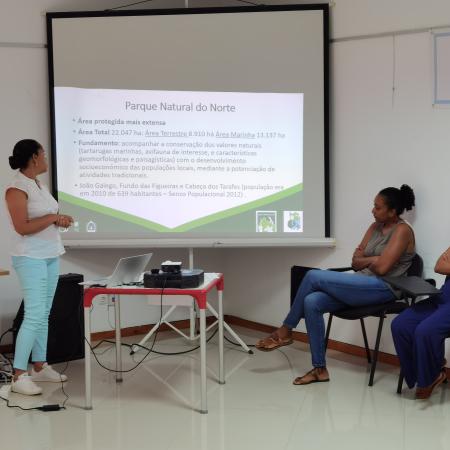
La responsable de la gestion des aires protégées de Boa Vista, Ivone Monteiro Delgado, a vraiment bénéficié de l'évaluation de l'EIPMF, qui lui a permis de
- d'identifier les menaces et les pressions au sein des aires protégées et d'évaluer leurs impacts et leurs tendances
- d'identifier les mesures et les actions permettant d'obtenir des résultats plus favorables
- d'identifier les faiblesses de la structure interne de la gouvernance, en particulier le manque de ressources humaines et matérielles
- Il est difficile de trouver des financements en raison de la dépendance à l'égard du gouvernement et, sans les ONG de Boa Vista, il serait presque impossible de mettre en œuvre le plan d'action des aires protégées.
- Identifier la nécessité de mettre à jour le plan de gestion actuel.
Elle aimerait répéter ce processus pour les autres aires protégées dont elle est responsable à Boa Vista et répéter l'évaluation en 2023 après la mise en œuvre d'autres projets ciblant les mesures prioritaires identifiées au cours de l'EIPMF.

